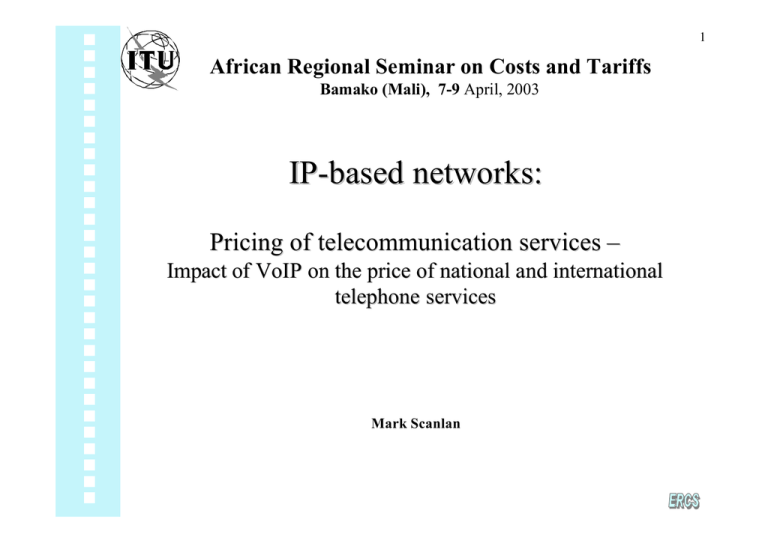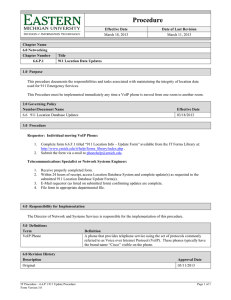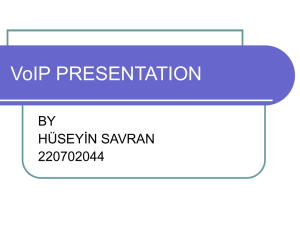IP - based networks: Pricing of telecommunication services
advertisement

1
African Regional Seminar on Costs and Tariffs
Bamako (Mali), 7-9 April, 2003
IP-based networks:
Pricing of telecommunication services –
Impact of VoIP on the price of national and international
telephone services
Mark Scanlan
2
Pricing & VoIP (1)
Ø The attractiveness of IP networks compared with circuit
switched networks, is that they provide:
– greater flexibility in network bandwidth requirements, and
– greater utilisation efficiency of available capacity
Ø The attractiveness of VoIP is driven by
1) Artificially inflated international PSTN call prices
2) ISP Membership but no usage fees
Ø Why this pricing structure?
– Because of the structure of prices small ISPs pay to large ones for
transit
– More fundamentally, it is because billing and metering systems on the
internet are limited in what they can do – especially regarding endusers
3
Pricing & VoIP (2)
Ø Transit contracts are confidential
Ø There appear to be three basic dimensions around which
transit price offers are structured:
– A fixed rate for a certain number of bits per month;
– A variable rate for bits in excess of this amount, and
– A rate based on peak throughput, which may include:
• pipe size, representing the option for peak throughput, and
• some measure of actual peak throughput (‘burstiness’).
Ø Lack of more sophisticated pricing e.g. congestion pricing,
results in congestion delays that make VoIP a poor quality
and unreliable service.
4
Pricing & VoIP (3)
Ø The attractiveness of flat rate pricing is also the Internet’s
weakness, i.e. poor QoS for real-time services
– All packets treated with equal priority
Ø Setting up and operating IP networks and especially VoIP,
requires technical skills –
– perhaps one reason why most VoIP occurs in South East Asia where
international PSTN calling rates are high and there is a highly
educated population.
5
VoIP: practicals (1)
Ø It seems likely that VoIP providers are using some
combination of the following:
– interoperability with the PSTN through SIP and H.323 terminals and
protocol groups, and the use of compression technologies;
– technical methods which keep datagrams on-net;
– dynamic assessment of the QoS on different parts of an ISP transit
network, such that calls are router where QoS is best at that moment,
and
– for computer to phone VoIP, computers connected via the PSTN to
UDP ports, which imply some QoS differences compared to TCP
Ø ISP networks are not based on a traditional PSTN
configuration where national operators in a country connect
with the outside World in international “no man’s land”
– ISPs that help provide VoIP are not defined by country boarders
6
IT Network Server
:
À:
IT Name Server
International IP Network
Terminating ISP
Originating ISP
IP Router
Ethernet Switch
IT Gateway
IT Gateway
È
PSTN
È
PSTN
Receiver
È
Country A
Caller
È
Country B
7
VoIP: practicals(2)
Ø This enables an ISP in Country A, to connect through a
gateway directly with the PSTN in Country B. In this way
an ISP can operate a WAN or WAE between two
countries.
Ø Involves the placement of interface devices and software
in countries A and B which transform messages originated
over the PSTN into IP, and for incoming messages visa
versa.
[1]
Ø Keeping the IP packets on-net enables a VoIP service of
acceptable QoS given price differentials with PSTN
8
VoIP: practicals(3)
Ø Where this IP model operates we should expect it to involve
large mainly urbanised populations as they can access the
ISP’s gateway without having to make an expensive long
distance call.
Ø It may be enough for VoIP to get the calling into a developed
and liberalised regulatory regime, as from here PSTN
termination into other liberalised countries is cheap.
Ø Computer to computer VoIP is simpler but is limited by the
distribution of computers and computer literacy (developing
countries!), and is likely to be of lower QoS.
Internet
É
Â
PSTN
'
'
À
:
ISP(A)
E WL
H
ETT
ACK
P
ARD
'
À
'
Off-net Internet call;
needs complex routing policy,
tunnelling & dynamic multihoming, & PSTN backup
‘Best effort’ QoS
too poor for VoIP
É
Â
Off-net IP/PSTN call
HE
WL E T
PA
CKA
RD
É
'
'
Router
'
'
À
'
ISP(C)
Â
:
À
É
On-net call;
QoS OK for
VoIP
PSTN switch
'
ISP(B)
É
'
'
'
HE
WL E T
PA
CKA
RD
À
:
'
:g H.323 / SIP gateway
Ég internet phone
'g PSTN phone
À
g ENUM address translation
9
10
Unliberalised World
Country A
Domestic PSTN
Switch
Liberalised World
Country B
Accounting rates apply:
perhaps 10X greater than cost
À
Domestic PSTN
Switch
À
Call originator
$0.50
$0.50
International
PSTN Switches
ISP
ISP
International
PSTN Switch
IT Gateway
PSTN International
half circuits
IT Gateway
$0.50
International IP Network
Competitive
{Calls at cost
including a
fair profit}
Accounting rates apply:
perhaps 10X greater than cost
International IP Network
À
ISP
IT Gateway
$0.50
$0.50
ISP
À
IT Gateway
Accounting rates apply:
perhaps 10X greater than cost
Country C
11
VoIP: practicals (4)
Ø Is VoIP going to have an important role in providing service
to developing countries?
Ø I will put my neck out and say not when looked at in
isolation. Why?
– VoIP is an accounting rate bypass service
– The telecoms problems of developing countries are not addressed by
whether international calls are VoIP or PSTN
Ø Many developing economies have underdeveloped networks,
even considering their low GDP per capita.
Ø Most user costs are in the access network and there are
thought to be only modest cost savings converting this to IP.
Value Flow
End-user
Subscriber line
and call charges
Local
infrastructure
12
Payment Flow
Services existing
independently of
the Internet
Subscriptions
Lease charges
Internet
Access
Transit Services
Advertising
Advertising/
hosting fees
Transit fees
Content
Delivery/
Web-hosting
Direct content order / Micro payments
Content/
Products
13
VoIP: practicals (5)
Ø There may be cost savings / economies of scope, for network
operators in developing countries to provide VoIP along with
Internet service.
Ø This has more to do with NGNs than VoIP per se
Ø People in developing countries need Internet access
– They need the information and communication it provides
– Many need to be taught what can be done with the Internet
– Programs to provide internet access to schools may be an effective
way of addressing this problem
– Donor money should be available as the information and education
provided is a driver of democratisation.
14
Conclusions
Ø QoS on the Internet is generally too poor for VoIP
Ø By keeping traffic on an international WAN or WAE, VoIP
quality appears to be acceptable in some cases, given the price
of the PSTN equivalent.
Ø The continued medium-term growth of VoIP appears
dependent on international accounting rates being maintained
at levels greatly above the relevant resource costs.
– i.e. VoIP is a regulatory by-pass service
Ø VoIP does not address the main telecoms problems in
developing countries; ’ network under-development.





